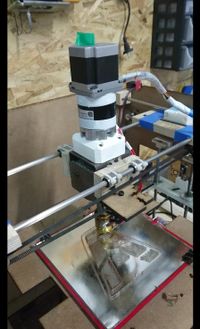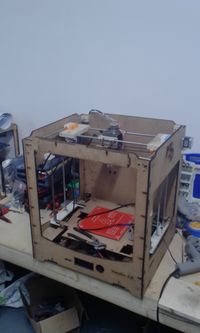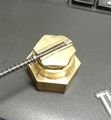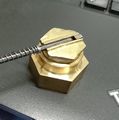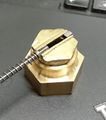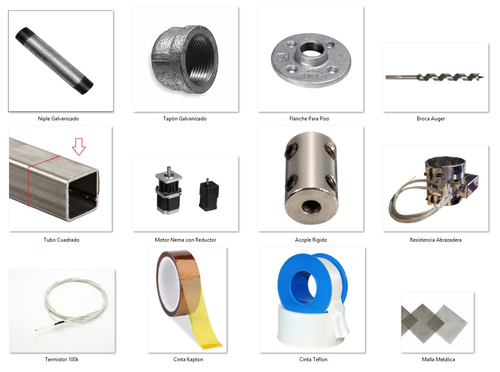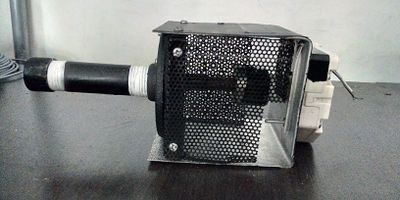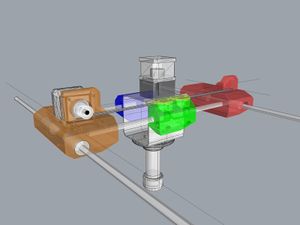Difference between revisions of "Pellet Extruder for 3D Printing"
(→Bill of Materials) |
(→Disclaimer) |
||
| Line 97: | Line 97: | ||
=== Assembly Manual === | === Assembly Manual === | ||
| − | === Disclaimer === | + | ==== Disclaimer ==== |
This is a Technical Tutorial for the construction of an Industrial Grade Device which means that only qualified and experienced personnel could execute and obtain the appropiate result without damage, if you dont feel in the capacity to perform the tasks I show in the following steps, dont worry, just find the appropiate place, the appropiate person and the appropiate tools to get it done, keep in mind that the most important thing is your integrity and security, this is not intended as a manual to harm yourself in the process, be careful with the instructions, try to make this work in a good mood and mind clear of alcohol or any other product that could affect your performance, I dont take any responsibility of the use of this information. | This is a Technical Tutorial for the construction of an Industrial Grade Device which means that only qualified and experienced personnel could execute and obtain the appropiate result without damage, if you dont feel in the capacity to perform the tasks I show in the following steps, dont worry, just find the appropiate place, the appropiate person and the appropiate tools to get it done, keep in mind that the most important thing is your integrity and security, this is not intended as a manual to harm yourself in the process, be careful with the instructions, try to make this work in a good mood and mind clear of alcohol or any other product that could affect your performance, I dont take any responsibility of the use of this information. | ||
| + | |||
| + | === Bill of Materials === | ||
| + | |||
| + | [[File:Materiales.png|500px|thumb|Materiales]] | ||
| + | *1 X Water pipe Nipple 1/2"(dia) x 3"(long) double thread, Iron or Copper | ||
| + | *1 X Water pipe cap 1/2"(dia) round, Iron or Copper | ||
| + | *1 X Floor Flange Fitting 1/2" thread, Iron or Copper | ||
| + | *1 X Auger bit 1/2"(dia) X 5" | ||
| + | *1 X Square structural tube 70mm x 70mm X 70mm (long), Iron | ||
| + | *1 X Nema 23 Stepper Motor with 1:72 Gearbox | ||
| + | *1 X Rigid Coupling 5mm to 12mm (for bit and motor shafts) | ||
| + | *1 X Band Resistive Heater 12v 90Watts 28mm(dia) X 30mm(long) | ||
| + | *1 X Thermistor EPCOS 100K | ||
| + | *1 X Kapton Tape de 30mm width | ||
| + | *1 X Teflon Tape | ||
| + | *2 X Metal Mesh Square 10x10cm | ||
| + | |||
| + | |||
| + | <gallery> | ||
| + | Pipe-1.jpg|Water pipe | ||
| + | Pipe-2.jpg|80px|Water pipe cap | ||
| + | Metal-mesh.jpg|Metal Mesh 10x10cm square | ||
| + | Square structural tube.jpg|Square Structural Tube | ||
| + | Floor-flange.jpg|Floor-flange | ||
| + | |||
| + | </gallery> | ||
| + | |||
| + | Manual Tools: | ||
| + | |||
| + | * Slot and Philips Screwdrivers | ||
| + | * Pliers | ||
| + | * Pipe Wrench | ||
| + | * Slim-Jaw Adjustable Wrench | ||
| + | * Allen Key Set | ||
| + | * Thread Tap M6 | ||
| + | |||
| + | |||
| + | Electric Tools: | ||
| + | |||
| + | * Multimeter | ||
| + | * Drill | ||
| + | -Drill Bits | ||
| + | -1" Saw Cup for Metal | ||
| + | * Angle Grinder | ||
Before we start there is something that we have to understand, is the fact that we are dealing with high density thermoplastics, those materials need high temperatures and lots of force to manipulate, it means that all the mechanics we are going to build here will be made out of metal, because of this, hard work with "heavy tools" are needed, the material I've succesfully used is iron due to their ideal heath transfer properties for this project, avoid of use alluminum, if it is a problem for you to find iron parts you can use bronze instead which has been proven to give good result. | Before we start there is something that we have to understand, is the fact that we are dealing with high density thermoplastics, those materials need high temperatures and lots of force to manipulate, it means that all the mechanics we are going to build here will be made out of metal, because of this, hard work with "heavy tools" are needed, the material I've succesfully used is iron due to their ideal heath transfer properties for this project, avoid of use alluminum, if it is a problem for you to find iron parts you can use bronze instead which has been proven to give good result. | ||
Revision as of 16:29, 18 November 2019
Contents
Project manager
| Maker | Image | Profile |
|---|---|---|
| Bustos Fabian |
Development team
| Maker | Foto |
|---|---|
| Miguel Duran |
| Maker | Foto |
|---|---|
| Sebastian martinez |
Introduction
After some years the FDM 3D printing patents and methods were released, the community started to discuss the fact that this industry is getting stuck, that FDM 3D printing is just a hobbie and a method for rapid protyping but not for serious applications in the serial production of products, due to this comments and bad publicity the members and developers of this project found a new way to change this reality, at this point the majority of 3d printing machines have three major problems to analyze and solve.
The first problem is about printing volume, when thinking about printing large objects the major limit is the cost of the material, if a printing session of a large object uses more than 2 rolls of filament the printing method can be discarded due to the cost and replaced by another techniques, this means that the 3D printing community fell into the consumption culture of inkjet printers for example, where the "brands" make more money by selling expensive cartridges of ink and tonners than by selling the actual paper printers.
The second problem is about printing time, due to the large list of coordinate movements that the machine executes to finish one model, the sum of this small portions of material deposed and time makes this FDM technology unsuitable for serial production or could even be seen as non-rapid prototyping method in some cases, analyzing the posibilities for upgrading a printing head to use a diferent technique of deposition, the solution points to increase the amount of plastic deposed versus time.
The third but not final problem depicted here, is the linearity of the materials, it means that if you have only one roll of white PLA plastic, you can only print white PLA models, if you want to make pieces of another color or if you want to make a model of multiple colors, you have to buy the same amount of rolls of plastic, its a good business model for the companies that release this technology for free to the people, but at the same time there is a huge economic interest which works effectively.
FM3D Pellet Extruder (In Spanish)
Problem #1: Printing Volume vs Cost
Looking around the social media, we can see that the majority of 3D printing machines are capable to print inside a volume less than 30 x 30 x 30 cm, it's due to the fact that those small volumes are enough to cover the average consumer necessities, because the system is made in that way, but if a new series of big 3d printers become popular and the materials cheaper?, the users would switch automatically to print big scale projects and the consommation of plastic increases. Curiously if you want to make a model that occupies all the volume of your 3D printer, you have to pay a price of plastic even major to the cost of the machine, it's a sad reality if we think about all the plastic we put into the trash every week.
Problem #2: Speed vs Productivity
23/05/2019
- We take as a fact that a big volume print is expensive and take a long time, until now we have achieved good performance on the Pellet Extruder using PLA pellets, which reduce the printing cost ten times compared with filament printing method.
To solve the printing time problem a variable volume printing nozzle has been designed, it's a extrusion tip that doesn't have a specific diameter orifice, it has a 1x10 mm groove. this one has a moving part that controls the material output at different times of the print. The operation principle is the same that an industrial type plastic sheet extruder has, but simplified to be installed in a moving shafts system.
Problem #3: Material Versatility
Extruder Design
Design and plans
- Link Design: https://www.thingiverse.com/thing:3836155
3D printer integration
Extruder Mechanics
The action strategy of the printing Tip is that when it is making outer perimeters the nozzle closes to let out a 1x1mm filament, that's how we can make the outer layers with good level of detailing, in the moment of filling the piece it opens up to 10mm wide and performs the work at least 6 times faster than a conventional extruder and when it is executing the displacements it closes completely to avoid unwanted extrusions before reaching the work coordinates.
Extruder Electronics
Assembly Manual
Disclaimer
This is a Technical Tutorial for the construction of an Industrial Grade Device which means that only qualified and experienced personnel could execute and obtain the appropiate result without damage, if you dont feel in the capacity to perform the tasks I show in the following steps, dont worry, just find the appropiate place, the appropiate person and the appropiate tools to get it done, keep in mind that the most important thing is your integrity and security, this is not intended as a manual to harm yourself in the process, be careful with the instructions, try to make this work in a good mood and mind clear of alcohol or any other product that could affect your performance, I dont take any responsibility of the use of this information.
Bill of Materials
- 1 X Water pipe Nipple 1/2"(dia) x 3"(long) double thread, Iron or Copper
- 1 X Water pipe cap 1/2"(dia) round, Iron or Copper
- 1 X Floor Flange Fitting 1/2" thread, Iron or Copper
- 1 X Auger bit 1/2"(dia) X 5"
- 1 X Square structural tube 70mm x 70mm X 70mm (long), Iron
- 1 X Nema 23 Stepper Motor with 1:72 Gearbox
- 1 X Rigid Coupling 5mm to 12mm (for bit and motor shafts)
- 1 X Band Resistive Heater 12v 90Watts 28mm(dia) X 30mm(long)
- 1 X Thermistor EPCOS 100K
- 1 X Kapton Tape de 30mm width
- 1 X Teflon Tape
- 2 X Metal Mesh Square 10x10cm
Manual Tools:
- Slot and Philips Screwdrivers
- Pliers
- Pipe Wrench
- Slim-Jaw Adjustable Wrench
- Allen Key Set
- Thread Tap M6
Electric Tools:
- Multimeter
- Drill
-Drill Bits -1" Saw Cup for Metal
- Angle Grinder
Before we start there is something that we have to understand, is the fact that we are dealing with high density thermoplastics, those materials need high temperatures and lots of force to manipulate, it means that all the mechanics we are going to build here will be made out of metal, because of this, hard work with "heavy tools" are needed, the material I've succesfully used is iron due to their ideal heath transfer properties for this project, avoid of use alluminum, if it is a problem for you to find iron parts you can use bronze instead which has been proven to give good result.
1.1 Cut 70mm of structural square tube of 70mm by 70mm, you can use the angle grinder with metal cutting disc, this cube will serve as container and the chassis of the extruder.
1.2 Use the Drill with the 1"Saw Cup to make two holes perfectly aligned at the center of the cube.
1.3 Place and center the flange in one hole, mark down the points where the screws will be placed, Place the motor on the other hole, carefully center the axle on the hole and mark down the points where the screws will support the motor.
Stages
- 0. Disclaimer
- 1. Building the Mechanics
- 2. Installing the Electrical system
- 3. Mechanic Efficiency Test
- 4. Thermal Efficiency Test
- 5. Pruebas de fluidez del material
- 6. Integración a la impresora 3D
1.Building the Mechanics
2.Installing the electrical system
Install the heating element, the heat sensor and motor wiring, this is connected to the machine's controller board.
3.Mechanical efficiency test
From the computer, send commands to the controller board to verify the correct movement of the pellets inside of the extruder, verify the speed and strength requirements.
4.Thermal efficiency test
From the computer, send commands to the controller board to verify the heating element performance and define the optimal temperature to melt the plastic and make it flow through the tube.
5.Material flow test
Heat the extruder to the work temperature obtained before, and define the motor's speed to produce a continuos string of plastic as fast as possible, maintaining the diameter and the material properties. In this step the lenght and material's retraction time are calculated, to get total control of the extrusion during an impression.
6.3D Printer integration
Use the temperature and displacement data to adjust the printer firmware parameters, this will be integrated to the machine and will always work as a normal extruder, the data will be used too in the software "slic3r" to generate G codes for the machine at different tempetatures, speeds, accelerations and retraction rates, make some test to adjust the settings for different models.
Additional advance
10/06/2019
Since the first assembly of the extruder, we used a Nema 17 motor of 2,2kg/cm Torque and 1:50 gearbox, which presented printing failures and loss of steps due to overheating, which also affected printing speed, something visible in the quality of the printed pieces, to solve this problem the motor has been replaced with a Nema 23 with 9 kg/cm torque and 1:72 gearbox, after the software adjustments and some tests, the extruder presented a better speed and acceleration control, and an improved print quality.
24/06/2019
- We have built a second printer that we will use exclusively for the development of the sheet extruder, it has a print volume of 300x400x300 mm, it was built using recycled materials, a whiskey box for the extruder and motors extracted from a paper printer, we use beer cans and resistive material from an old toaster for the heating element of the extruder.
A stepper motor with gearbox has been installed on the tip of the extruder, which moves a rod along a groove with 10 mm wide and 1 mm diameter, this mechanism has been built entirely by hand with the help of a motortool and a manual drill.
Project Status
07/11/2019
- We are working on a 3D model of the public domain printer.
- Progress is being made in the construction of the printer
24/10/2019
- We are printing the necessary pieces for the assembly of the printer.
12/08/2019
- The printer has been cleaned, removed unnecessary or damaged items and started to write the shopping list
24/06/2019
- A temporal Method to generate Gcode for the Machine with CNC software and manual edition for Gcode archives has been found.
- A professional with knowledge in mathematics and programing is required for generate the codes that will make the extruder work properly.
10/06/2019
- We designed the parts for the printer, to eplace the temporal parts, the machine will create this pieces in the second week of June
Repository for 3D printed parts [1]
20/05/2019
- We are making simulation on Rhinoceros Grsshopper, for the Gcode generation.
- Post process tests have been done in Slic3r with Perl Language for the Gcode generation.
- A professional with knowledge in mathematics and programing is required for generate the codes that will make the extruder work properly.
